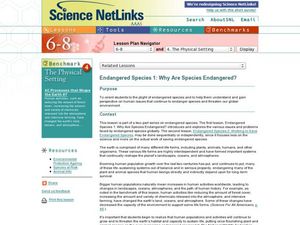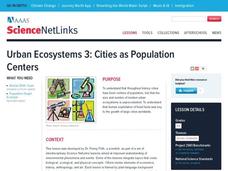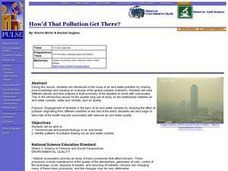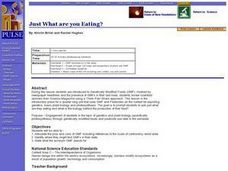Curated OER
Our Population and Its Impact on the Planet
Students explore environmental problems due to the growing worldwide human population and examine the growth rate. They also discuss possible ways to stabilize population growth and increase sustainable development.
Curated OER
Population Density in the Ghettos
Students make calculations of population density to recognize the stressful conditions experienced by European ghetto dwellers due to high population density and scarcity of resources.
Curated OER
Population Biology
In this population worksheet, students will determine if 12 statements about demographic trends, including the effects of birth and death rates on populations, are true or not. Then students will match 6 population growth vocabulary...
Curated OER
Endangered Species 1: Why are Species Endangered?
Emerging ecologists examine endangered species by visiting the US Environmental Protection Agency website. They consider human contribution to the decline of different species. They research an endangered animal and then craft a poster...
Curated OER
Population Needs vs. Population Deeds
Pupils examine the recent population explosion of the world. After watching a demonstration on closed systems, they identify the role humans have on the depletion of natural resources and lowering the standard of living. To end the...
Curated OER
Population Density in the Ghettos
Students examine population density in Jewish ghettos. In this Holocaust lesson plan, students calculate population density of cities around the world using the provided information. Students then discuss the implications of high...
Curated OER
World in the Balance
Students explore population growth. They calculate how long it takes a country's population to double in size and to investigate factors affecting growth rate. In addition, they list of factors they think might affect growth rate
Curated OER
Urban Ecosystems 3: Cities as Population Centers
Middle schoolers discover that throughout history cities have been centers of population but that human exploitation of fossil fuels was key to the growth of large cities worldwide. They research urban growth through a number of websites.
Curated OER
Overpopulation vs. Overuse of Resources
Tenth graders identify the consequences of human population growth. In this biology lesson, 10th graders debate on whether overpopulation or overuse of resources is more harmful to humans. They write a reflection at the end of the...
K12 Reader
Endangered Species
Your learners have likely heard about animals going extinct. By reading this passage, they can find out some reasons why this happens and how to protect endangered species. After reading, individuals respond to five related questions.
Curated OER
HIV/AIDS And Contemporary Population Dynamics
Students describe the spread and occurence of HIV/AIDS at multiple scales. They explain global and regional variations in the occurence of HIV/AIDS and explain the spread of HIV/AIDS in the United States.
Howard Hughes Medical Institute
Lactase Persistence: Evidence for Selection
What's the link between lactase persistence and dairy farming? Biology scholars analyze data to find evidence of the connection, then relate this to human adaptation. Working individually and in small groups, learners view short video...
Curated OER
Social Studies: Devastating Diseases
Students are able to critically read literature addressing historical data and answer relevant questions. They are able to formulate an opinion and support it using all knowledge documented and learned in this and previous lessons.
Advocates for Human Rights
Who are Immigrants?
What do Jerry Yang, Patrick Ewing, John Muir, Charlize Theron, Peter Jennings, and Saint Frances X Cabrini all have in common? They are all immigrants to the United States. Famous and not-so-famous immigrants are the focus of a resource...
Curated OER
Endangered Species 1: Why Are Species Endangered?
Students are oriented to the plight of endangered species and to help them explain and gain perspective on human issues that continue to endanger species and threaten our global environment.
Curated OER
Diversity
Eleventh graders research the meaning of diversity and human rights in various countries. For this Social Studies lesson, 11th graders reflect on the aspects that can negatively affect First Nations people, then select a country...
Curated OER
Environment: How'd That Pollution Get There?
Students examine how global wind and water patterns aid in the spread of worldwide pollution. In groups, they read articles about the domino effect of pollution and create posters displaying its journey. On blank world maps, students...
Curated OER
The Global Impact of Insect Borne Diseases & Agriculture
Students study the global impact of insect borne diseases, the appropriate use of pesticides, and the concept of human interrelations on a world wide scale. They examine how to safely apply a pesticide, according to the label.
Curated OER
Going Global
Students describe the importance of aquaculture as a source for protein intake by humans globally. They are given a number from 1-3 as they enter the class. All "1's" recieve 10 beans. All "2's" recieve 5 beans. All "3's" recieve 1 bean....
Curated OER
Radical Raptors
Students define raptor, explain why raptors are important, describe unique physical characteristics of various types of raptors, and explain life cycle of raptors. Students then play Habitat Game, describe food and hunting habits of...
Curated OER
Just What are you Eating?
Students identify and articulate pros and cons of genetically modified foods (GMF) including references to scale of controversy worldwide. Students then identify where they might find GMFs in their diets, read different opinion pieces on...
Curated OER
Zhuang: China's Largest Minority
Students, in groups, research Chinese ethnic minorities such as the Zhuang population. They identify the characteristics of different ethnic groups and consider the lives of ethnic groups worldwide.
Howard Hughes Medical Institute
The Making of the Fittest: Got Lactase? The Co-evolution of Genes and Culture
Got milk? Only two cultures have had it long enough to develop the tolerance of lactose as an adult. Learn how the responsible genes evolved along with the cultures that have been consuming milk. This rich film is supplied with a few...
Curated OER
Endangered Species !: Why Are Species Endangered?
Students explore the various issues and problems faced by endangered species globally. They research the plight of endangered species, create a poster of a selected animal, and present their poster and research to the class.























